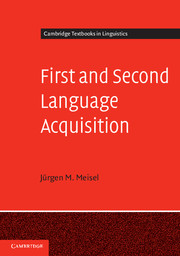Book contents
- Frontmatter
- Contents
- List of figures
- List of tables
- Preface
- List of abbreviations
- 1 The quest for the LAD
- 2 First language development: Universal Grammar as the centrepiece of the human language making capacity
- 3 Obvious (observable) similarities and differences between first and second language acquisition: Developmental sequences
- 4 The initial state and beyond
- 5 Developing grammatical knowledge: Parameter setting and inductive learning
- 6 Neural maturation and age: Opening and closing windows of opportunities
- 7 A (tentative) theory of language acquisition – L1, 2L1 and L2
- Glossary
- Notes
- References
- Index
- References
3 - Obvious (observable) similarities and differences between first and second language acquisition: Developmental sequences
Published online by Cambridge University Press: 05 June 2012
- Frontmatter
- Contents
- List of figures
- List of tables
- Preface
- List of abbreviations
- 1 The quest for the LAD
- 2 First language development: Universal Grammar as the centrepiece of the human language making capacity
- 3 Obvious (observable) similarities and differences between first and second language acquisition: Developmental sequences
- 4 The initial state and beyond
- 5 Developing grammatical knowledge: Parameter setting and inductive learning
- 6 Neural maturation and age: Opening and closing windows of opportunities
- 7 A (tentative) theory of language acquisition – L1, 2L1 and L2
- Glossary
- Notes
- References
- Index
- References
Summary
Observable phenomena
The tour d'horizon undertaken in the previous chapter, surveying some core aspects of the human Language Making Capacity, was designed to provide us with the necessary means for formulating the kinds of questions which, when answered adequately, should reveal essential properties of the learners' (transitional) grammatical competence. Although my goal is to discover similarities and differences in first and second language learners' underlying knowledge systems, I will begin by examining phenomena which are directly accessible by observation. In a second step, questions will be asked which aim at deeper insights, inquiring whether the observed commonalities reflect common underlying knowledge and whether differences should indeed be explained as reflecting distinct knowledge bases or different mechanisms of language use.
Uniformity has been argued to be a crucial property of L1 development. As far as the developmental chronology of grammatical items and structures is concerned, we see remarkably little variation across individuals. Moreover, children tend to make the same types of ‘errors’, avoiding other types of deviations from the adult norm which, in principle, might have been expected to occur. Findings of this sort suggest that L1 development is guided by an underlying mechanism shared by all learners, possibly the LAD we are searching for. It is therefore a reasonable research strategy to inquire whether similarly invariant acquisition sequences can be found in L2 acquisition.
- Type
- Chapter
- Information
- First and Second Language AcquisitionParallels and Differences, pp. 62 - 89Publisher: Cambridge University PressPrint publication year: 2011



